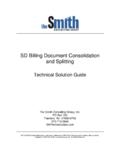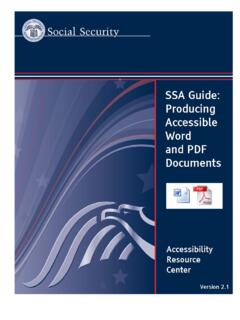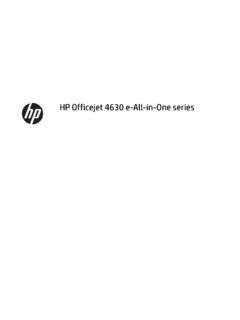Transcription of Using MS-Query - Dan Flak
1 Using MS-Query 1 2 2 Installation .. 2 3 The 2 4 Setting Up Data Sources .. 2 Selecting the Database Source Type .. 3 Selecting the 4 Selecting the 4 Selecting the Columns .. 5 Filtering the Columns .. 5 Sort the Data .. 6 Setting up to Read a Parameter at Run Time .. 7 Import the Data .. 8 Redefining Runtime Parameters .. 9 Finishing Up .. 10 5 Setting up a New Data Source .. 11 6 Importing Text Files .. 13 7 query Behaviors .. 15 Push 15 Inserting Columns .. 16 Changing Source Location (Excel Spreadsheets) .. 16 Changing Source Code Location (MS-Access).
2 17 8 20 This Data Source Contains No Visible Tables .. 20 No Header When Linking to a Text File .. 22 Created on 1/26/08 Copyright 2009 Dan Flak Page 1 of 22 Using MS-Query Using MS-Query 1 Introduction Do you find yourself frequently needing information contained in a database, another spreadsheet, or a text file in your spreadsheet? Do you have to apply formulas to this data? Do you need to filter it and sort it at run time? MS-Query can do all of this for you. This tutorial explains how to set up a data source, generate a query , and set up parameters to run your reports. 2 Installation MS-Query is part of Excel, but is normally not activated until used. The first time you attempt to use it, you will be prompted to install it. Depending on how Office was installed, you may or may not need to use the installation CDs. Follow the prompts to complete the installation. Once installed, MS-Query will always be available.
3 3 The Database In this document you will learn how to set up queries to attach to MS-Access Databases, Excel Spreadsheets and text files. You will also learn how to import from a text file. The data source we will be working with contains the following information. The Database NameGender OccupationBailey, BeetleMalePerpetual PrivateBumstead, BlondieFemale CatererClampett, JedMalePoor MountaineerDrew, NacyFemale Amateur DetectiveFlintstone, FredMaleDino OperatorKent, ClarkeMaleMild Mannered ReporterPossible, KimFemale StudentWoman, WonderFemale Crime FighterZiffle, ArnoldMaleBarnyard Animal These data sources, for the purposes of this tutorial are in C:\Temp and are named: Access Database: (tbl_people) Excel Spreadsheet: Text File: These files are contained in the zip file. Download them to C:\Temp if you want to follow along with the exercises. 4 Setting Up Data Sources MS-Query has the ability to read data from various sources.
4 Please note: the instructions presented here are for Office 2003. Microsoft likes to change the user Page 2 of 22 Using MS-Query interface with each release, if you are Using another version of office, your displays may look different. For all applications, the process starts with invoking the External Data menu. Select Data Import (or Get) External Data New Database query . This action will bring up a menu similar to the following: External Data Menu Selecting the Database Source Type Selecting New Database query brings up the following dialog box. Data Source(Type) Dialog Box Page 3 of 22 Using MS-Query Selecting the Database Setting up the basic query is the same for any of the data sources with minor variations. For example, selecting the MS Access option brings up the following dialog box. Database Selection Dialog Box Microsoft is very fond of mapped drives. If you are planning to share the spreadsheet and query with others who may not map their drives the same way as you, specify the full path name rather than Using the dialog box to navigate to the data source.
5 For example \\Server Name\Data Sources\Data Source Name. In the case of an Access database, you will be given a list of available tables and queries. Note: Do not select queries that prompt for a parameter. Doing so will cause an error message later on in the process. See section for setting up parameters. In the case of an Excel spreadsheet, you will be given a list of page names and named ranges if the named ranges are static. Named ranges that are dynamic will not be displayed. Selecting the table table Selector Dialog Box From this point on, all the query methods continue in the same fashion. Page 4 of 22 Using MS-Query Selecting the Columns Once you select the table you can select which columns you want to display. Column Selection You can select individual columns or if you click the > while the table is selected, all columns will be moved over. Filtering the Columns You can choose which records are passed on by the query .
6 Filter Dialog Box Note: You can only set up fixed parameters with this part of the wizard. You cannot set up a prompt or formula. To set up parameters that can be set at run time, see section Page 5 of 22 Using MS-Query Highlight the column on which you want to filter. You can select multiple and/or criteria for this parameter. You can also select additional columns for filtering. Selecting an item will activate the dropdown list of the operators. Some of the options are Sort the Data You can also perform three levels of sort Using the next dialog box. Sort Order Dialog Box Page 6 of 22 Using MS-Query Setting up to Read a Parameter at Run Time You can skip this section if you do not need to read a parameter at run time. You can always edit the query and get back to this screen later. Finish Dialog Box To exit back to Excel, select Return Data to Microsoft Office Excel.
7 To set a parameter for run time, select View Data or Edit query in Microsoft query . Selecting the view data option will bring up a dialog box showing the results of the query . To add a criteria, click on the Show/Hide Criteria icon (eye glasses and funnel. Microsoft query Tool Bar This action will open up the criteria section of the dialog box. You can drag the column name into the criteria field, or use the drop-down list to select the column ed later. Type in the value for the criteria. In this step, make the parameter interactive by Using square brackets []. This choice can be changIn this case, we are setting up the parameter to look at a string (that can accept wildcards) to match to the gender. Page 7 of 22 Using MS-Query Once you set up the parameter, you will be prompted for it. Interactive Parameter Prompt Import the Data Once you have the query set up the way you want it, you will be prompted where to put it.)
8 The cell definition is where the top, left of the returned data will be placed. You can put the query anywhere on the page. See the discussion on query behavior in Section for additional information. Normally the query is written to cell $A1 or cell $A2. If the query has nice headers and you want to keep them, return the data to cell $A1. If query has oddly-named headers and you want to suppress them, return the data to cell $A2. Page 8 of 22 Using MS-Query Redefining Runtime Parameters If you set up a query to read parameters at runtime, you can set them to be read by right clicking on the returned data set. This action brings up a menu as shown in the illustration at right. Select Parameters from this menu. This action will bring up a dialog box as shown below. This option will not be available on the menu unless an interactive query is set up as in Section Parameters Dialog Box Use this box to: Prompt the user for a value Use a value.
9 The value can be a constant like Female or a formula like =today(). Get the value from a cell. Page 9 of 22 Using MS-Query Finishing Up Now that you have the data returned, it is time to define some of the behavior. Right click on the data set and get the menu shown in section This time select Data Range Properties. This action will give you the dialog box shown below. Data Range Properties Dialog Box Select the options that make the most sense for you. Shown here are the defaults. To suppress headers, uncheck Include Field Names. You might also wish to uncheck Adjust Column Width with this options. A word or two about Fill Down Formulas in Columns Adjacent to Data: This option works on all columns immediately adjacent to the right of the data set. The formulas on the top row are replicated for each row of data returned. MS-Query also cleans up after itself and removes excess formulas if subsequent refreshes return fewer rows.
10 A break in the continuity of the formulas (that is, a blank column) stops the replication, so you can set up summary calculations in this area. Page 10 of 22 Using MS-Query 5 Setting up a New Data Source There are two ways of getting text information into Excel. The first method is to define the directory in which text files reside as a data source. Then you can use any text file within the directory as a data source To start the process select Data Import (or Get) External Data New Database query New Data Source. Select the Microsoft Text Driver In the resulting dialog box, uncheck the Use Current Directory box. Page 11 of 22 Using MS-Query Select the folder containing your data sources. When you are done, the original dialog box should look something like: Click OK and you are brought back to a familiar screen. You can now use the newly-created data source in the exact same way as other data sources.







